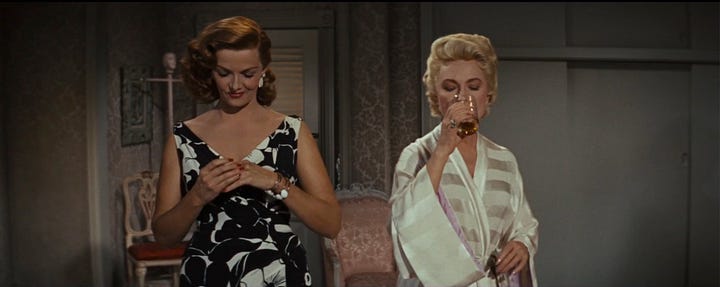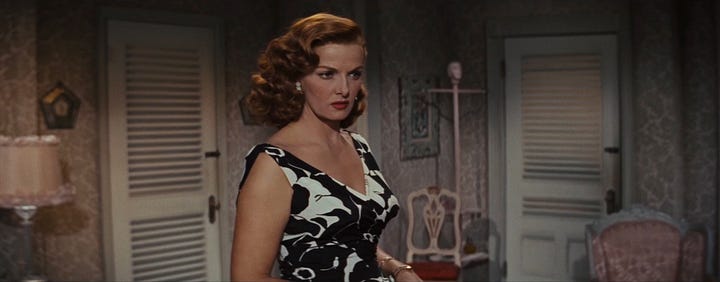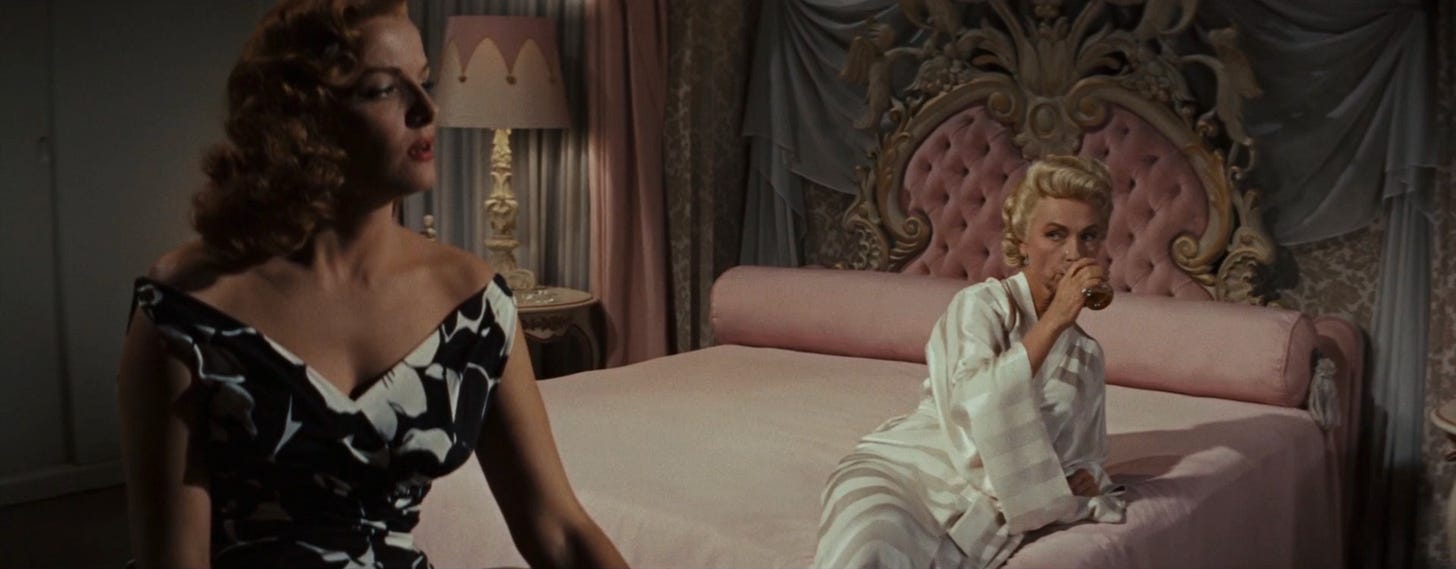Blocking for Shifting Sympathies in THE REVOLT OF MAMIE STOVER
The scene below is five minutes, worth a watch for the performances alone (Agnes Moorehead and Jane Russell are the film’s most dynamic pairing) but the breakdown is actually quite short, and mostly photos of each new configuration.
Today we’re keying in on blocking rearrangements which keep the scene dynamic: when they come, how the characters are positioned in relation to each other, and whose face(s) the audience can focus on.
0:00-0:41


Mamie (Russell) and Bertha (Moorehead) walk into Bertha’s room and begin with pleasantries — would you like a drink, why are humans always trying to fool each other and ourselves?
The camera moves slowly towards and away from them, but what’s most interesting to me here is how Bertha circles Mamie, like a bird of prey.
0:42-1:13
The camera moves out as Bertha sits down on the bed, so we still get a clear view of them both as for the first time a stark unevenness in their height.
Bertha’s action is an unspoken invitation for Mamie to relax, both because it’s a casual seating (her bed) and she’s made the first move to (literally) lower herself.
Mamie does sit, but perching on a chair higher than the bed; she’s unwilling to completely concede the high ground; when the camera cuts in for a more angled two-shot, Mamie is top of frame.
We can see both of their faces as Bertha tempts Mamie to stay on as a hostess. proposing a pay rise and profile boost.
1:13-1:50
Mamie stands as she refuses the offer, putting herself literally above Bertha as she claims she loves a man, and Bertha retorts all men will disappoint her.
1:51-2:11
To really drive home her point about men promising the world to women like them, only to run out, Bertha stands back up to Mamie’s level.
2:12-2:27
Mamie sits fully in the chair, slouching down as she swoons about Jimmy. Bertha looks directly down on her and scoffs before sitting again.
2:28-2:44
Even though they’re both sitting, Mamie is now lower in frame.
When it cuts to the angled-two-shot, the camera has changed its angle slightly, so we can see Mamie below and Bertha above, but still see both their faces clearly.
2:45-3:30
Bertha gets up and ‘circles’ Mamie again, before sitting down on the chair facing her, trying with body language as well as words to convince Mamie “I’ve been exactly where you are, we are the same, forget Jimmy and we can thrive.”
We see mostly Bertha’s face here, Mamie only in half-profile; being completely ‘open’ to camera helps us believe Bertha is telling the truth, while we’re unsure what Mamie thinks about it.
3:31-4:00


Mamie stands and heads for the door; Bertha stops her with words “I tell ya what . . . “ before getting up and following.
The negotiation has begun, and they’re back where they started, standing with their eyes at the same level.
They’re not squarely facing each other, or us, but we can still clearly see Mamie’s face, and see Bertha’s side profile as well as her eyes in the mirror.
Their singles also keep them at the same size / height in frame.
Note the warmer set / lighting colour behind Bertha and the cooler set / lighting behind Martha.
4:00-end
Bertha walks to Mamie and they finish the conversation how they began: on even ground, at the door.
The ‘warmer left / cooler right’ continues, and we get gorgeous pattern clashes; sworls on the wallpaper, hard stripes of Bertha’s dressing gown and the door slats, stark black and white patterns on Mamie’s dress.


Takeaways
The scene is at its core two women having a five-minute negotiation about their emotional entanglements and business interests, rooted in their past heartache and future desires.
Blocking could be as simple as them sitting on either side of a table; the actors could absolutely still light it on fire.
But in them physically repositioning as they verbally spar, it visually lays out their conversation as a fight, and keeps things dynamic and interesting, more actively swaying our allegiances back and forth. It’s a wonderful use of the Cinescope aspect ratio as well as the room’s layout, furniture, and backgrounds.
Consider in your two-hander how the characters can ‘dance’ around each other to demonstrate (or act as direct counterpoint to!) what they’re actually saying.











